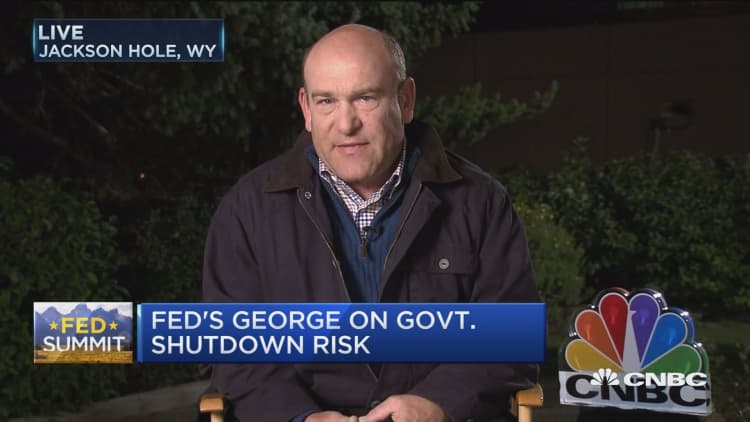As central bankers gather at the annual Jackson Hole symposium on Friday, analysts think the death of a major economic concept could dominate discussions.
Known as Phillips curve, an economic concept developed by New Zealand economist William Phillips, it shows that inflation and unemployment have a stable and inverse relationship.
However, in the recent months with central banks using artificial ways to pump money into the economy, this inverse relationship is seen to be dying.
A number of analysts have warned that this could be risky for the global economy and discussions around the death of the Phillips curve could dominate the Jackson Hole symposium.
"The inverse relationship between unemployment and inflation is dead. The proliferation of low-wage, irregular and insecure jobs means that wage pressures - and therefore spending power - are subdued even as unemployment falls," Edward Smythe, an economist at Positive Money, told CNBC via email.
Smythe added that this is bad news for policymakers wishing to unwind quantitative easing, and bring interest rates back to their pre-crisis levels.

Central bank's two-pronged approach
Central banks around the world have pegged their monetary policy on unemployment and inflation growth. Major banks such as the U.S. Federal Reserve, the European Central Bank and the Bank of England have been hoping to see unemployment levels go down and inflation go up with some central banks setting a target of 2 percent.
Recent economic data, however, shows a downward movement in unemployment rates but inflation lagging gains.
"Earlier this year, U.S. inflation appeared to be grinding higher in the context of steady economic growth and a tight labour market," Michael Hood, global multi-asset manager at J.P. Morgan Asset Management, told CNBC via email.
"The core CPI inflation rate, which excludes food and energy prices, hit 2.3 percent year-on-year in February. And the core PCE deflator, the index targeted by the Federal Reserve, ran at a 1.8 percent year-on-year clip in that same month, within shouting distance of the Fed's 2 percent goal. Our forecasts called for ongoing, gradual acceleration. Instead, inflation has gone into reverse during the past several months, with both indices dipping well below 2 percent in year-over-year terms. By some measures, wage inflation has also cooled recently."
ECB struggling with the Phillips Curve?
The ECB too recently cut its inflation outlook in June. Mario Draghi, president of the ECB, said that the central bank now anticipates inflation levels of 1.5 percent in 2017, 1.3 percent in 2018 and 1.6 percent in 2019. This is down from the forecasts released in March, which saw inflation reaching 1.7 percent in 2017, 1.6 percent in 2018 and 1.7 percent in 2019.
Meanwhile, minutes from July's ECB meeting showed a lengthy discussion of the disconnect between inflation and employment. The ECB attributed this to a number of factors that were likely to be of a more structural nature.
"These included changes in labour markets, work contracts and wage-setting processes, benefiting from the reforms introduced in previous years, which could imply a structural break in the Phillips curve," according to the minutes.
On inflation, several analysts have said that there are a number of structural factors responsible for keeping inflation down in developed markets.
Alberto Gallo, head of macro strategies and manager of the Algebris Macro Credit Fund, told CNBC earlier this week that these factors include the scars left on the economy and labour markets by the recession, misallocation of resources due to prolonged low-interest rates, new technologies maximising resource-sharing and stagnant demographics.
Is QE exit the answer?
Gallo thinks central bankers should still look at removing artificial stimulus, for three reasons.
"First, it is becoming less useful. Persistent low-interest rates can become deflationary over time, as today's ageing populations save more, while firms focus on cost savings following a balance sheet recession. The second is QE has side-effects, including the formation of asset bubbles, which may endanger the financial system. The third is to build an adequate policy buffer to face any future risk."
He, however, warns that coordinating an exit will be very difficult as it requires agreement among central banks, with the additional uncertainty coming from fiscal policy in each country.
Central bankers gathering in Wyoming have a lot on their plate this weekend and markets are all ears for any hints coming out of the Jackson Hole Symposium. One analyst has warned that schizophrenia will be the biggest theme at Jackson Hole this weekend.
"The central bankers will want to say they are still in charge and have done a great job …….while being evasive on subjects like the Phillips curve and possible major adverse reactions in the equity and bond markets to their policy changes," Alastair Winter, chief economist at Daniel Stewart, told CNBC via email.
WATCH: Here's why Draghi, not Yellen, is the central focus this week at Jackson Hole



